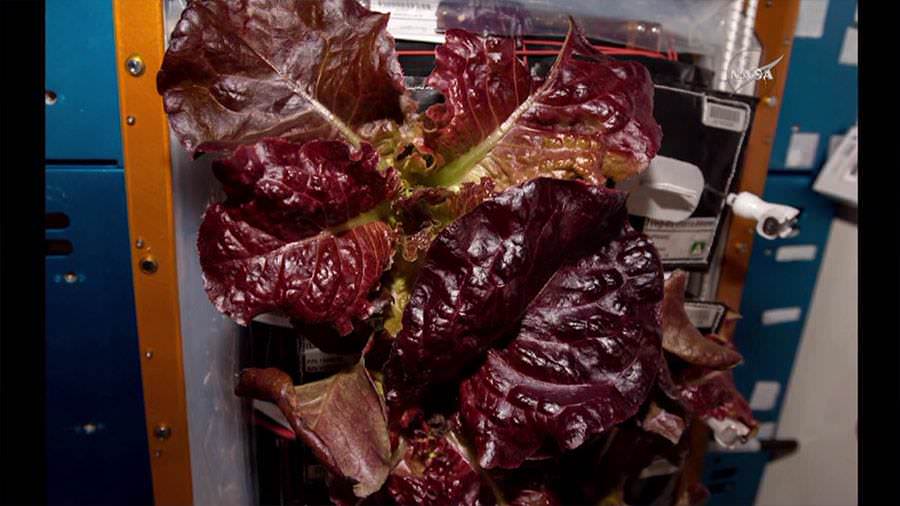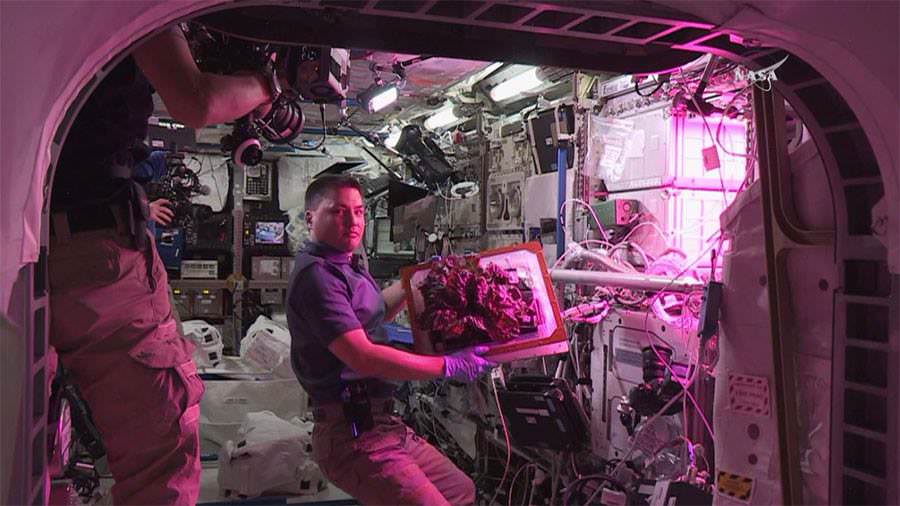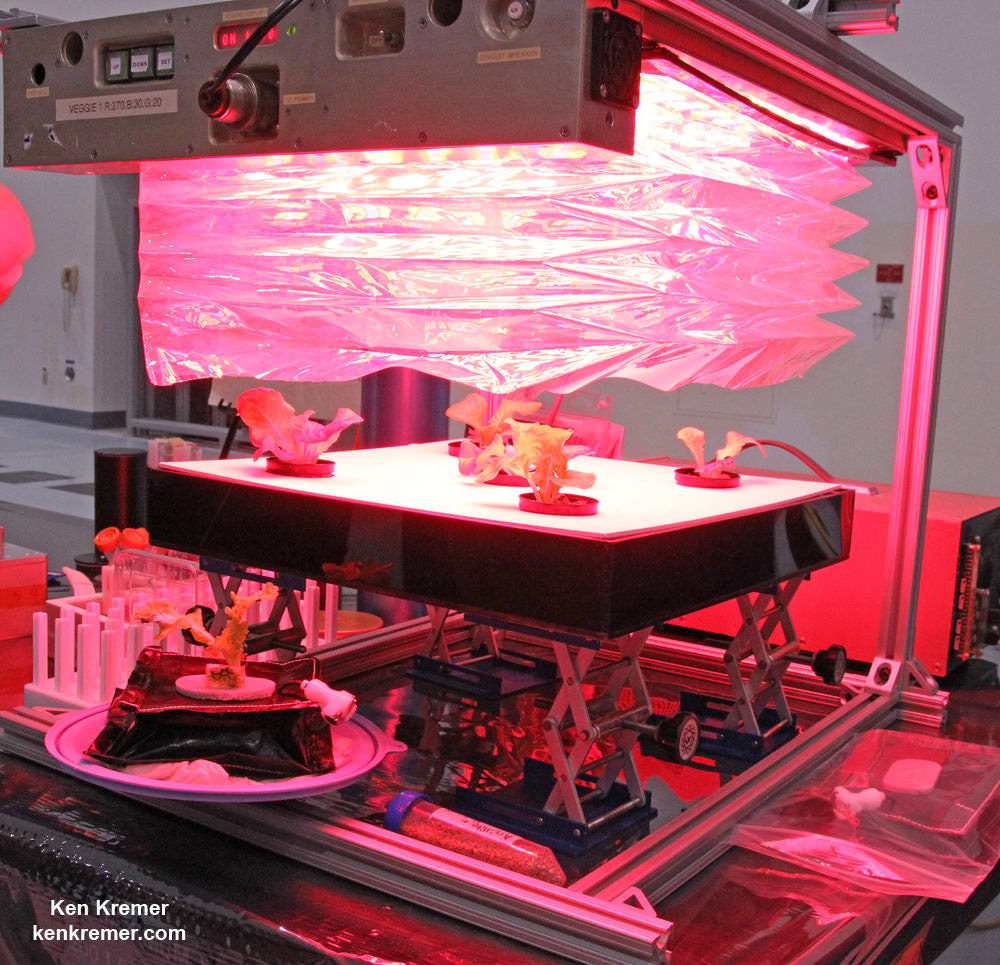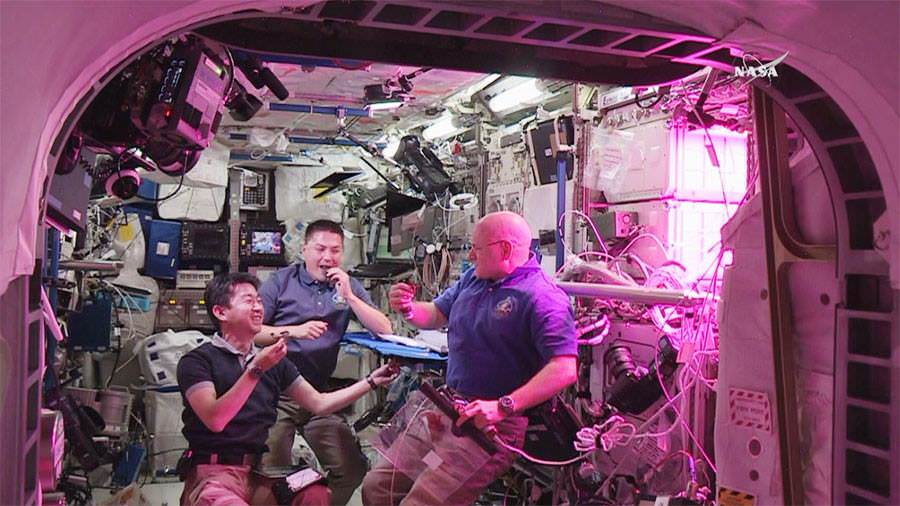Video caption: That’s one small bite for a man, one giant leaf for mankind: NASA Astronauts Scott Kelly, Kjell Lindgren and Kimiya Yui of Japan sample the fruits of their labor after harvesting a crop of “Outredgeous” red romaine lettuce from the Veggie plant growth system on the International Space Station. Credit: NASA TV
Going where no astronauts have gone before, a trio of “space farmers” living aboard the International Space Station (ISS) have just become the first humans ever to eat food grown in space!
The gleeful munchers downed the freshly harvested crop of blood red colored “Outredgeous” red romaine lettuce salad during a live webcast today, Monday, August 10, direct from the Earth orbiting outpost soaring some 250 miles (400 km) above the home planet.
“Woo hoo ! …. Cheers!” exclaimed the eager Expedition 44 astronauts comprising Kjell Lindgren, Scott Kelly and Kimiya Yui, at the moment of truth, as they consumed the fruits of their own labor.
“It was one small bite for man, one giant leap for #NASAVEGGIE and our #JourneytoMars. #YearInSpace,” tweeted Kelly.
The momentous salad eating event took place at 12:26 EDT from beside the innovative and groundbreaking “Veggie” plant growth system, housed inside the European Space Agency’s Columbus laboratory located at the end of the US section of the ISS.
“That’s awesome!” said Lindgren with a broad smile – to the audible crunchy sounds of chewing on the freshly cut space lettuce.
“Tastes good!” replied Kelly, upon happily consuming the red leafed vegetable. He is now in the 5th month of his planned 1 Year mission aboard the ISS.
“Chomp! Our first veggies were harvested & consumed by astronauts in space!” tweeted NASA.
They all welcomed the opportunity to sample some freshly grown space produce from their miniature “ space farm.” Resident ISS crewmembers have been waiting for the “GO” to eat for some time.
“It tastes like arugula,” added Kelly, as they first tried the lettuce plain, as a control taste test of the virgin crop to get “the full effect.”
“It’s fresh,” Lindgren responded.
Then they doused quickly it with some oil and vinegar for flavor comparison.
“After trying the lettuce plain, @astro_kjell and @StationCDRKelly added oil & vinegar!” NASA tweeted.
Lindgren had carefully and methodically snipped away about half of the lettuce crop, on live NASA TV – which had grown to quite a size under the carefully maintained conditions inside “Veggie.”
He then cleaned “the leafy greens” by placing them between citric acid-based, food safe sanitizing wipes before the taste test.
After momentarily bagging the harvest, he distributed samples to his “tastemates” and the fun began.
“It’s wonderful to eat fresh food on the ISS, which is a lot of white and aluminum and it’s kind of a sterile environment,” said Kelly.
So this was quite different.
“It’s really fun to see green, growing things in here that we’re intentionally growing for sustenance. So we sure appreciate this payload and the opportunity to grow and eat and harvest these crops.”
The joyful trio saved some for the produce for their three Russian station colleagues to try later – Oleg Kononenko, Gennady Padalka and Mikhail Kornienko. Two of the Russian cosmonauts, Expedition 44 commander Padalka and Kelly’s 1 year crew mate Kornienko, were conducting a spacewalk today, simultaneously to the lettuce taste testing.

Another portion was set aside “to be packaged and frozen on the station until it can be returned to Earth for scientific analysis,” said NASA.
Although some vegetables have been grown before on the station, including prior crops of lettuce from “Veggie,” today marked the first time that any astronauts were “officially” granted “permission” to eat the fruits of their labor. Russian cosmonauts have eaten their station crops in the past. It’s a mystery whether any partner crewmates surreptitiously tasted some of the Russian produce.
And it not just for fun. In fact growing edible space food marks a significant new milestone towards enabling deep space human exploration, as explained by Kelly.
“Having lived on the space station for a while, I understand the logistical complexity of having people work in space for long periods and the supply chain that’s required to keep us going,” Kelly remarked.
“If we’re ever going to go to Mars someday, and we will, we’re going to have a spacecraft that is much more self sustainable with regard to its food supply.”
Experiments like these are critical for NASA’s plans to send humans on a “Journey to Mars” in the 2030s.
The “Journey to Mars” and back is likely to take well over two years and resupply is not possible. Crews will have to grow at least a portion of their own food and today’s experiment helps pave the human path to the Red Planet.
The “Veggie” experiment was developed by Orbital Technologies Corp. (ORBITEC) in Madison, Wisconsin.
The Veggie-01 apparatus was thoroughly tested at Kennedy before flight. It was delivered, along with two sets of pillows containing the romaine seeds and one set of zinnias, to the ISS by the SpaceX-3 Dragon cargo resupply mission launched in April 2014.

The lettuce crop inside the Veggie-01 plant pillows were activated by Kelly on July 8. They were grown for 33 days before being harvested today. The seeds had been stored dormant on the station for some 15 months since arriving aboard the SpaceX-3 Dragon, according to NASA.
The collapsible and expandable Veggie unit features a flat panel light bank that includes red, blue and green LEDs for plant growth and crew observation.
Stay tuned here for Ken’s continuing Earth and planetary science and human spaceflight news.



The most expensive garden ever…
Well done to the ISS – why has it taken so long?
A food that is really “out of this world” (Before anyone else says it)
Roseland Observatory – UK
Hey, but I want a green lettuce!
Not many calories in lettuce and probably takes more energy to digest that can be used. No protein, no fat. They’re going to have to do a lot better than a few leaves of lettuce to support life in space. Legumes would be a good next step.